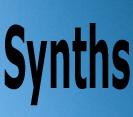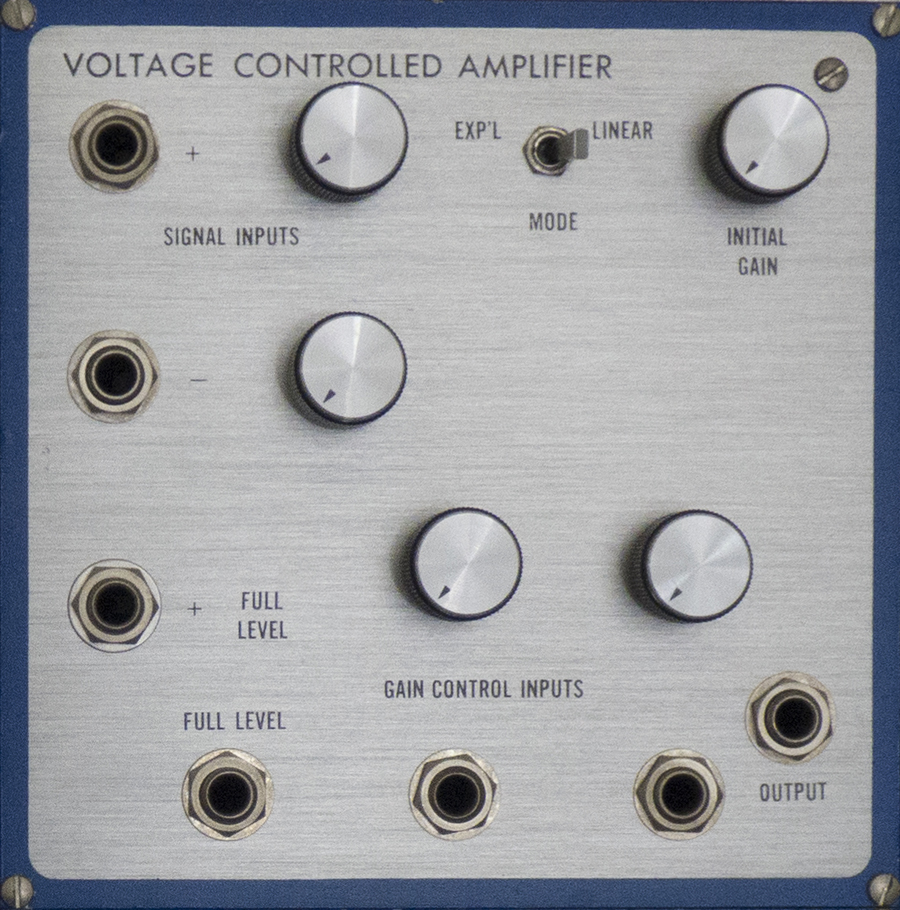


THE E-MU MODULAR
E-mu Amplifiers
E-mu Modular Technical Information |
AdditionalInformation |
E-mu Modular System 2017 |
|
Main Page |
1977 Modular Brochure |
E-mu Modular System Keyboard |
|
Voltage Controlled Oscillators |
Other Modules |
More Modular Pictures |
E-mu Modular System Modules |
- > Voltage Controlled Amplifiers |
Modular Cabinets |
Rossum Interview |
E-mu Modular System Inside |
Voltage Controlled Filters |
E-mu SSM Board |
E-mu Modular System Sounds |
Click on a section above to go to a specific area about the E-MU Modular.
 |
Eµ MODULE 2000 - VOLTAGE CONTROLLED AMPLIFIERThe Eµ 2000 Voltage Controlled Amplifier is an exponentially and/or linearly controlled amplifier for envelope shaping or control functions. It contains an Eµ 1001 VCA submodule. The top two signal inputs pass through their respective attenuators, and are summed with the full level input. The result appears at the output, amplified by a factor determined by the control inputs. The second signal input is inverting for increased flexibility. The control inputs are similarly summed with the initial gain control (which effectively varies from -5 to +5 volts) to produce the total input control voltage. The 3 position mode switch determines the function of the control voltages. In linear mode, the amplifier has zero gain for total control voltages below zero, and the gain increases linearly above zero, passing through unity at +5 volts. In exponential mode, the amplifier again has unity gain at +5 volts, and changes 10 dB per volt around this point. With the mode switch in the center position, the two left most control inputs and the initial gain control behave the same as in linear mode. The right most control input, however, acts as a multiplier on the gain, with a sensitivity of 10 dB per volt. Maximum gain available from the amplifier is approximately +6 dB.
Power Requirements: ±15 V @ 12 mA typical
Firm-wire Patch Connections: Inputs Signal (2) Control (2) Outputs One (3 pins) Power Bus Connected Inputs: None Adjustments Master Gain Exponential Gain Control Rejection |
Eµ MODULE 2010 - QUAD VOLTAGE CONTROLLED AMPLIFIERThe Eµ 2010 Quad VCA module is an array of four independent linear two quadrant multipliers, using two Eµ 1010 submodules. It is particularly useful for spatial modulation and voltage controlled mixing. Each of the four identical VCA sections can function totally independently. The gain at zero control voltage for each VCA is determined by the associated initial gain control. Setting the control left of center always results in zero gain, but as the control is rotated further counterclockwise, more control voltage is required before the VCA begins to pass any signal. The effective control polarity may be selected by a switch for each VCA. In the + position, the gain is increased for positive control voltages, in the - position it is decreased. Hence a single control voltage applied to two control inputs can turn one channel on and the other off. This is most useful in mixing and panning operations. The lag control introduces a finite attack and decay into the control path. This is useful when digital signals are used on the control inputs, as it eliminates the pops resulting from sharp attacks. The lag time is variable from a few microseconds to approximately 0.1 second. As a convenience for voltage controlled mixing, the sum of the four VCA outputs is available. Note that this output is inverting. Each signal input is internally pre-patched to the input above it, so that to use a single signal source for all four VCA's it need only be patched to the top input. If two inputs were required, each to a pair of VCA's, one would patch to the first and third inputs. This of course aids in voltage controlled panning operations. The control inputs are similarly pre-patched for voltage controlled mixing.
Power Requirements: ±15 V @ 30 mA typical
Firm-wire Patch Connections: None Power Bus Connected Inputs: None Adjustments Control Rejection (4) |
Silicon Breakdown has been a source of free information and pictures for analog synthesizers since 1999
The Music side of this site contains the sounds of Silicon Breakdown and various other musical adventures. MUSIC HERE
The Synth side showcases beautiful instruments from the past. ANALOG SYNTHESIZER INFO HERE
send comments to james AT siliconbreakdown.com (replace AT with @)
